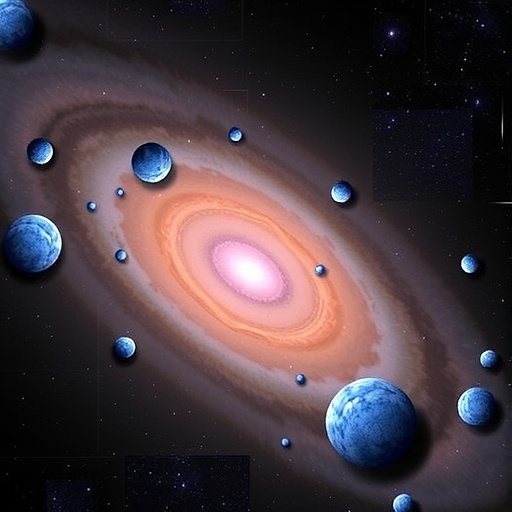The revolutionary findings heralded from The Australian National University (ANU) mark a significant breakthrough in our understanding of the cosmos. Astronomers have discovered a new class of binary stars, uncovering details that are pivotal for piecing together the formation and evolution of the Milky Way galaxy. This groundbreaking research emerges from the efforts of an ambitious ten-year project known as the Legacy Survey of Space and Time (LSST), operated from the Vera C. Rubin Observatory located high in the Andes Mountains of Chile.
Dr. Giacomo Cordoni, the lead author of this transformative study, emphasized that the LSST aims to create an extraordinary “movie of the universe.” This dynamic initiative endeavors to capture a comprehensive snapshot of the Southern Hemisphere’s sky every few nights, ultimately tracking billions of stars and galaxies and how they evolve over time. Such an endeavor signifies a historic moment in astronomical research, as it provides the tools to unravel the intricate history of star clusters and the broader galaxy.
One of the primary focuses of the study encompasses globular clusters, which represent some of the oldest and densest star systems in the universe. Each globular cluster is a powerhouse of stellar interactions, containing hundreds of thousands of stars within a relatively confined space. This crowded environment presents an ideal natural laboratory for researchers to explore concepts such as stellar evolution and interstellar interactions. The Milky Way itself boasts over 150 known globular clusters, with 47 Tucanae standing out as a noteworthy example, becoming visible to the naked eye in the Southern Hemisphere’s sky and often serving as a benchmark for theoretical models regarding cluster evolution.
The research team successfully utilized the initial public dataset from the Rubin Observatory, known as Data Preview 1, to uncover the presence of binary stars within the outskirts of 47 Tucanae for the first time. Researchers found that the frequency of binary star pairs in these outer regions is astonishingly about three times greater than in the more densely populated central regions of the cluster, which have previously been scrutinized using the Hubble Space Telescope. This revelation suggests that as binaries venture into the congested heart of the cluster, they face significant disruption, while those inhabiting the quieter peripheries can resiliently survive, thereby preserving a population closer to the cluster’s original composition.
The implications of these findings resonate deeply within the astrophysics community, given that 47 Tucanae has been a subject of intense study for over a century. Dr. Luca Casagrande, a co-author of the study, reflected on the remarkable turnaround, stating that endeavors like the LSST enable astronomers to map not just the denser central parts of these clusters but also their elusive outskirts. This newfound ability to analyze the fringes of globular clusters promises to enhance our understanding of how these stellar systems assemble over cosmic timescales.
In addition to advancing the scientific discourse surrounding globular clusters, this discovery is pivotal in enhancing our comprehension of how binary stars influence cluster longevity and dynamics. Binary stars serve as key players in these crowded star populations, facilitating energy exchange and mediating interactions that can lead to the formation of extraordinary celestial objects, like luminous blue stars dubbed blue stragglers. These fascinating phenomena emerge from the complex relationships and evolutionary paths found within star clusters, elucidating a narrative of stellar relationships that is paramount to understanding our universe.
The researchers assert that their discovery represents a crucial new piece in the extensive puzzle of how globular clusters—some of the oldest constituents of the Milky Way—have come to be. By shedding light on the dynamics of binary stars within these clusters, they have forged a pathway that could lead to definitive insights into the formation processes of both clusters and galaxies at large. The Rubin Observatory’s capabilities exemplify what can be achieved with modern astronomical instruments, as highlighted by co-author Professor Helmut Jerjen, who noted how even the initial test data from LSST is already transforming the approach toward stellar populations and dynamics.
As the LSST continues its decade-long mission, it promises to deliver unprecedented insights into the structures and behaviors of binary stars across the universe. This comprehensive census of stellar systems not only provides a new lens through which to study the formation and evolution of the cosmos but also allows for a decisive test of existing theories regarding the interplay of stars and their environments.
In conclusion, this pioneering research illuminates a promising frontier in our comprehension of the universe, inviting further inquiry and fostering deeper understanding of how star systems coexist and evolve over time. The LSST, paired with ongoing studies on globular clusters, has positioned itself as an emerging beacon of knowledge, further steering the ship of cosmic discovery into uncharted waters laden with potential revelations.
Subject of Research: Binary stars in globular clusters
Article Title: Rubin Data Preview 1: Extending the view of unresolved binary stars in 47 Tucanae
News Publication Date: 9-Oct-2025
Web References: arXiv, DOI
References: None
Image Credits: RubinObs/NOIRLab/SLAC/NSF/DOE/AURA/A. Pizarro D.
Keywords
Binary stars, globular clusters, Vera C. Rubin Observatory, LSST, Milky Way, stellar evolution, cosmic discovery.




